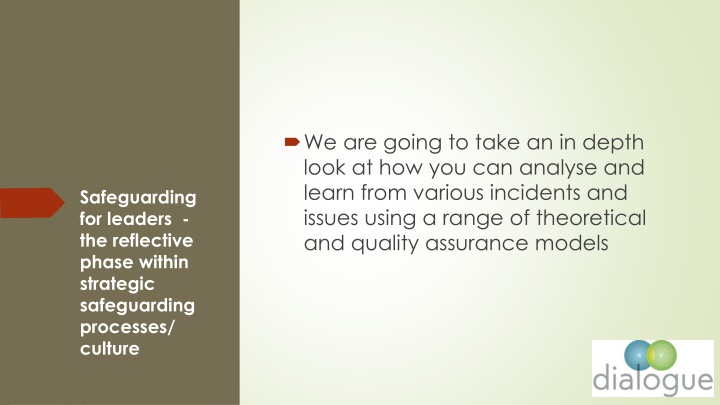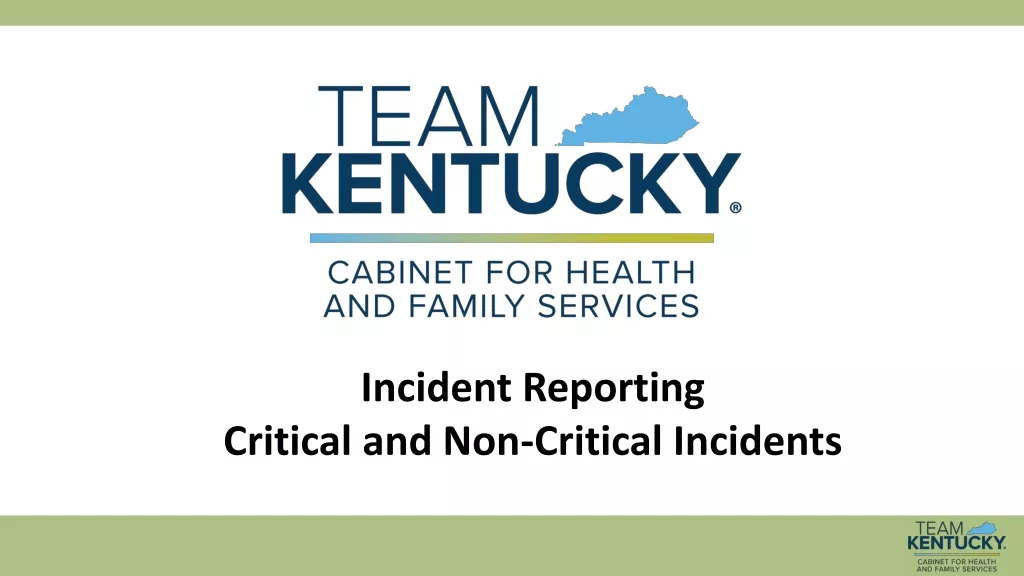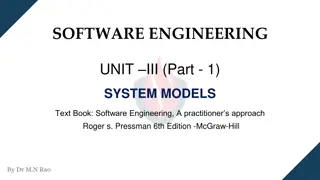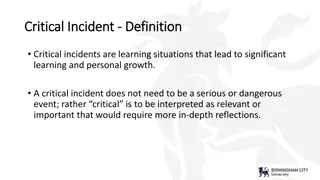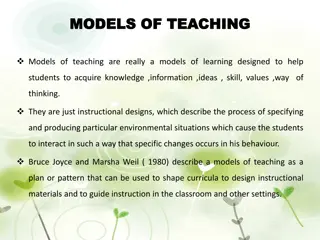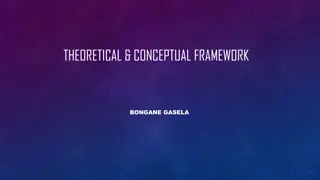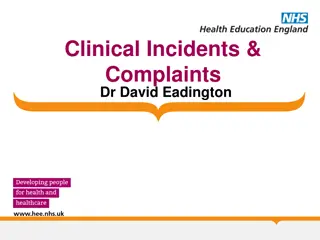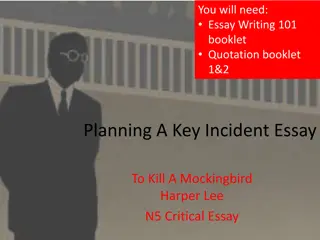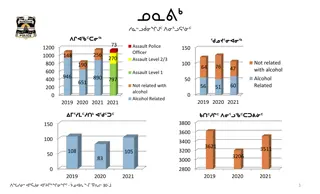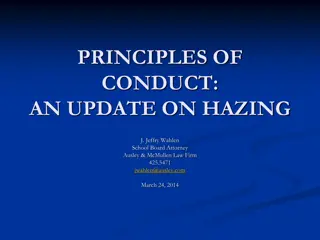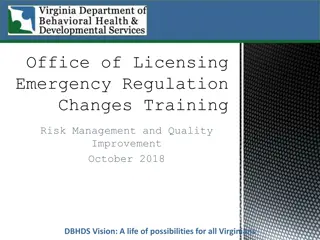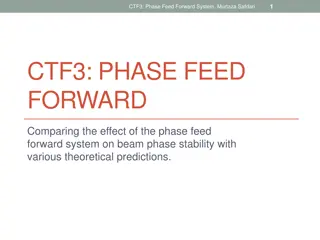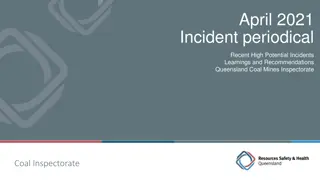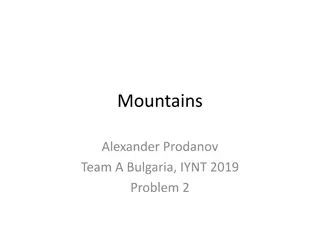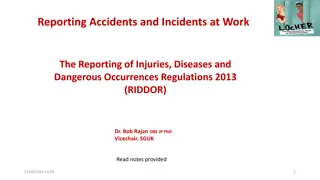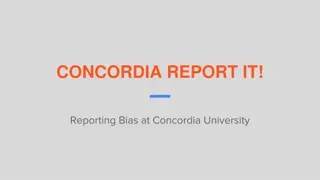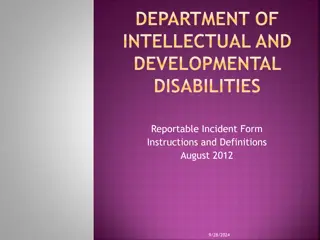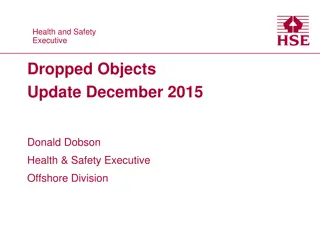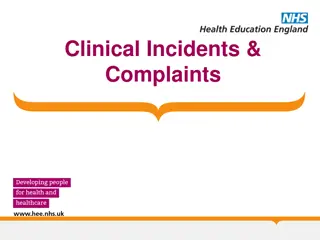Analyzing Incidents and Learning from Issues Using Theoretical Models
In-depth exploration of incident analysis and learning process using theoretical models and quality assurance approaches. Emphasis on the reflective phase within strategic safeguarding processes to enhance leadership skills and organizational culture. Techniques like root cause analysis and the 5 Whys are discussed to uncover underlying issues effectively. The session aims to develop a strategic view of safeguarding, understand risk factors, and promote a robust safeguarding culture for continuous improvement.
Download Presentation

Please find below an Image/Link to download the presentation.
The content on the website is provided AS IS for your information and personal use only. It may not be sold, licensed, or shared on other websites without obtaining consent from the author.If you encounter any issues during the download, it is possible that the publisher has removed the file from their server.
You are allowed to download the files provided on this website for personal or commercial use, subject to the condition that they are used lawfully. All files are the property of their respective owners.
The content on the website is provided AS IS for your information and personal use only. It may not be sold, licensed, or shared on other websites without obtaining consent from the author.
E N D
Presentation Transcript
We are going to take an in depth look at how you can analyse and learn from various incidents and issues using a range of theoretical and quality assurance models Safeguarding for leaders - the reflective phase within strategic safeguarding processes/ culture
Safeguarding - the reflective phase. Current good practice asks that we are: - Professionally curious - Non assumptive - Forensic - Non biased - As uncomfortable as it can be some of the best practice learning comes from applying all of these attitudes on a daily basis and particularly when an incident , safeguarding issue , accident , issue has arisen . - It can be very uncomfortable- it should be honest and a basis for learning - It should involve everyone on the team at some point
Aims of session 3 To be able to take a strategic view within the service/ organisation re. safeguarding in all aspects this underpinned by an understanding of risk To understand the structure and impact that a robust safeguarding CULTURE brings. To further develop your capacity to carry out and identify key learning and changes using theoretical approaches to incident analysis
Root Cause. A root cause is a factor that caused a nonconformance and should be permanently eliminated through process improvement. Root cause analysis is a collective term that describes a wide range of approaches, tools, and techniques used to uncover causes of problems. Sounds dire !!! Can t you tell it came from the car industry! Rephrased it means that:- Root cause analysis is an approach for identifying the underlying causes of an incident so that the most effective solutions can be identified and implemented.
The 5 Whys? By repeatedly asking the question Why (five is a good rule of thumb), you can peel away the layers of symptoms which can lead to the root cause of a problem. Very often the ostensible reason for a problem will lead you to another question. Although this technique is called 5 Whys, you may find that you will need to ask the question fewer or more times than five before you find the issue related to a problem. It is easily completed by a team who can often identify the sequence of events or issues and find the root cause themselves. This is always a good outcome if the issue lay within the team.
Why were you late for work? My car ran out of petrol Why did it run out of petrol? Because I did not put any in Why didn t you put any in ? Because I had no money Why did you have no money? Because I left my purse at home Why did you leave your purse at home? Because I slept poorly last night and forgot it. If you don t ask the right questions, you don t get the right answers. A question asked in the right way often points to its own answer. Asking questions is the ABC of diagnosis. Only the inquiring mind solves problems. Edward Hodnett
What do you do when you have a problem/incident/ accident / pattern at work? Do you jump straight in and treat the symptoms, or do you stop to consider whether there's actually a deeper problem that needs your attention? If you only fix the symptoms what you see on the surface the problem will almost certainly return, and need fixing over, and over again. Small group work to identify why this happens so often then feedback Tracing a Problem to its Origins
Root Cause Analysis (RCA) is a popular and often- used technique that helps people answer the question of why the problem occurred in the first place. It seeks to identify the origin of a problem using a specific set of steps, with associated tools, to find the primary cause of the problem, so that you can: Determine what happened. Determine why it happened. Work out what to do to reduce the likelihood that it will happen again. RCA assumes that systems and events are interrelated. An action in one area triggers an action in another, and another, and so on. By tracing back these actions, you can discover where the problem started and how it grew into the symptom you're now facing. Tracing a problem to its origins cont d
You'll usually find three basic types of causes: Physical causes Tangible, material items failed in some way Human causes People did something wrong, or did not do something that was needed. Human causes typically lead to physical causes Organisational causes A system, process, or policy that people use to make decisions or do their work is faulty
Step approach RCA assumes that systems and events are interrelated. An action in one area triggers an action in another, and another, and so on. By tracing back these actions, you can discover where the problem started and how it grew into the symptom you're now facing. Step One: Define the Problem What do you see happening? What are the specific symptoms? Step Two: Collect Data What proof do you have that the problem exists? How long has the problem existed? What is the impact of the problem? ** There is no point looking for solutions until the problem is identified**
Step Three: Identify Possible Causal Factors What sequence of events leads to the problem? What conditions allow the problem to occur? What other problems surround the occurrence of the central problem? During this stage, identify as many causal factors as possible. Too often, people identify one or two factors and then stop, but that's not sufficient. With RCA, you don't want to simply treat the most obvious causes you want to dig deeper. DIG!! Use the 5 whys?? Use Ishikawa Cause and effect diagrams- aka The Fishbone. Ask so what? Work with the team Step approach continued
Step approach continued .. Step Four: Identify the Root Cause(s) Why does the causal factor exist? What is the real reason the problem occurred?
Step approach continued .. Step Five: Recommend and Implement Solutions What can you do to prevent the problem from happening again? How will the solution be implemented? Who will be responsible for it? What are the risks of implementing the solution? Analyse your cause-and-effect process, and identify the changes needed for various systems. It's also important that you plan ahead to predict the effects of your solution. This way, you can spot potential failures before they happen.
Follow on.or starting point- it can be both! Failure Mode and Effects Analysis (FMEA) Spotting Problems Before a Solution Is Implemented Asking the question - "What Could Go Wrong? This is particularly useful where high levels of risk are involved. You can use this when considering a high risk placement you identify what could go wrong and then look at the risk profile generated. Are these risks you can reasonably, safely mitigate?
Follow on.or starting point- it can be both! Impact Analysis Identifying the Full Consequences of Change. while doing the TRCA and identifying changes to made take a little time to think things through. If we do this how will it impact on ..? Avoid confusion and disruption later on and the I wish I had thought of that moment.
Ishikawa or Fishbone model of cause and effect According to Ishikawa, quality improvement is a continuous process, and it can always be taken one step further. With his cause and effect diagram (also called the "Ishikawa" or "fishbone" diagram) this management leader made significant and specific advancements in quality improvement. It is best used with your team/ group at some point in the process . Ensure everyone feels safe Identify the problem which has occurred Brainstorm everything that should be in place so that the issue should not have arisen. Look at your headings- was everything in place as it should have been ? Did everything happen as it should have? IF NOT WHY NOT? USE THE 5 WHYS. IDENTIFY THE ROOT CAUSE.
Root cause analysis- from problem- part example Training Policies, procedures Up to date, fit for purpose. Up to date Competency based Clear , reviewed, known to staff Problem which has occurred Competency based Checks, processes procedures External audit Practice , processes CF.RCA.
Other factors to consider Equipment People in the broader sense Visitors Other professionals Environment Health and safety Safeguarding Legislation frameworks which should be in place and adhered to. Any more?
What can you use it for? Use it with an impact assessment Staff turnover Patterns of staff issues arising Patterns and issues arising from anything! Repeated medication errors at any stage in the process Pattern of increased numbers of REG 40 notifications New processes you want to introduce Equipment failure Accidents
Now the uncomfortable bit in any RCA ! You cannot assume . You have to : - THINK THE UNTHINKABLE- - Could it be deliberate - Could it be malicious - Could someone have fabricated illness think Beverley Allitt - Brainstorm it all.
ROOT CAUSE ANALYSIS WHOLE OR PART CASE STUDY
HILLSIDE IS A HOME IN CRISIS HILLSIDE IS A CHILDREN S HOME OFFERING CARE AND SUPPORT FOR THREE YOUNG PEOPLE , OF EITHER GENDER AGED 7-17 YEARS . THE HOME OFFERS CARE AND SUPPORT TO YOUNG PEOPLE WHO MAY HAVE A : - LEARNING DISABILITY/ SOME LONG TERM MEDICAL CONDITIONS - AUTISTIC SPECTRUM DISORDER - SOME BEHAVIOURAL CHALLENGE IN 2017 THE HOUSE WAS JUDGED BY THE REGULATOR TO BE GOOD; IN 2018 THE LONG ESTABLISHED REGISTERED MANAGER LEFT FOLLOWED BY THE DEPUTY AND ONE SENIOR. A NEW RI WAS ALSO APPOINTED TO THE ORGANISATION- THEY WERE NEW TO THIS ROLE. DURING THIS PERIOD OF CHANGE IT WAS NOTED THAT THE STAFF TEAM WERE VERY UNSETTLED AS WERE THE YOUNG PEOPLE. THIS APPEARED TO RESULT IN A RISE IN INTERVENTION , REG 40 NOTIFICATIONS , INCIDENTS ETC
HILLSIDE CONTINUED:- THE NEW MANAGER LEFT AFTER 6 MONTHS AND THE ORGANISATION RECRUITED AN INTERIM MANAGER WHILST FULL RECRUITMENT FOR A PERMANENT MANAGER WAS UNDERWAY. AT THIS POINT THE HOME WAS DEEMED TO REQUIRE IMPROVEMENT IN LEADERSHIP AND MANAGEMENT/ SAFEGUARDING INCLUDING IN BEHAVIOUR MANAGEMENT ,TRAINING, CONSISTENCY AND RECRUITMENT OF STAFF AND ADMINISTRATION OF MEDICATION. THIS VISIT WAS GENERATED BY A WHISTLEBLOWING REPORT IN EARLY 2019 A YOUNG PERSON WAS ADMITTED TO HOSPITAL FOLLOWING THE SERIOUS MALADMINISTRATION OF MEDICATION- FOR SEIZURES. THIS RESULTED IN A THREE DAY HOSPITAL STAY FOR THEM. THE LOCAL AUTHORITY MADE THE DECISION THAT THE YOUNG PERSON WOULD NOT RETURN TO HILLSIDE. THE REGULATOR VISITED THE HOME AND DEEMED IT TO BE INADEQUATE.
DISCUSS POTENTIAL ROOT CAUSES OF THIS SITUATION OR ONE ELEMENT OF THIS SITUATION . ALTHOUGH I HAVE NOT GIVEN YOU A HUGE AMOUNT OF DETAIL AS SENIOR LEADERS WITH EXPERIENCE OF REGULATION YOU WILL BE ABLE TO INFER SOME ISSUES AND POTENTIAL CAUSES OF THE SITUATION THIS HOME IS IN . TASK WORK IN YOUR GROUP AND CARRY OUT A ROOT CAUSE ANALYSIS BASED ON THIS OUTLINE INFORMATION USING THE INFORMATION WE HAVE DISCUSSED THIS MORNING. NOMINATE ONE PERSON TO FEEDBACK. YOU HAVE APPROXIMATELY 25-30 MINS FOR THIS EXERCISE
Next steps when your plan is in place MONITOR MONITOR and MONITOR ! Especially when your plan is a consequence of a serious incident Don t let it drift Tweak it if it needs to be done. Is it working? If not , why not? Get people together and ask the question. And MONITOR>>>>>>>>>
WHAT DO I NEED TO GO AWAY AND REVIEW / COMPLETE? LETS DISCUSS IT, ADD IT TO YOUR OWN SERVICE REVIEW.
